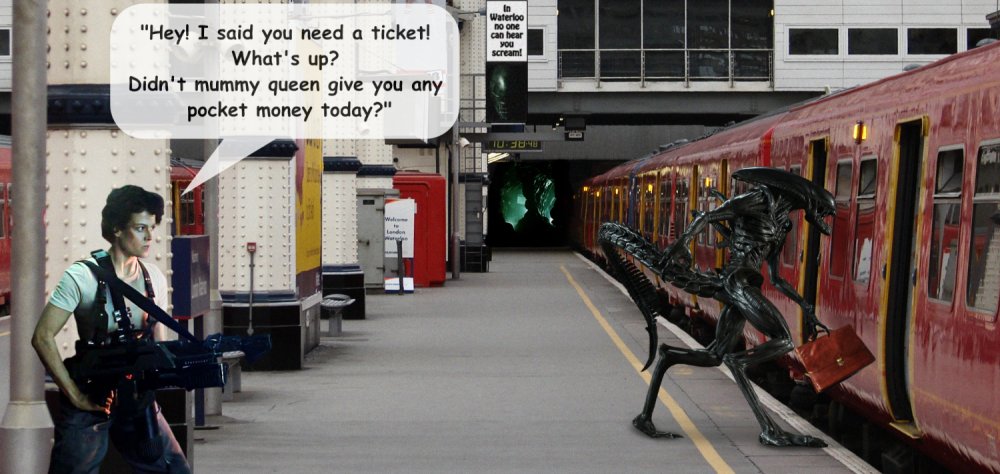-
Posts
672 -
Joined
-
Last visited
Posts posted by AffinityJules
-
-
Nice.
Was this done using the V word?
-
-
Good grief!
- Patrick Connor and emmrecs01
-
 2
2
-
5 hours ago, peter said:
Yeah! With Dutch/Arnie as the ticket collector or guard.
Ha!
Maybe in another picture, another scenario, but for me it was always going to be Ripley.
-
Very high quality work.
Makes me speechless.
-
I've only just found this.
Thanks muchly. . .one can never have enough brushes.
-
It is true to say that I like the element of humour above all else in my photo composites. That's not to say I have no serious creative side, and there are times when this serious aspect of my character has a need to be fed when it surfaces. I like to play around with the results of my photography in the sense that, I experiment and try to turn an image into something completely different than what the camera lens has captured by employing heavy, picture altering manipulation, and editing techniques. I begin such endeavours with no clear idea or preconceived plan, it's a case of let's see what happens.
The picture below actually came from a photograph I took of an LED light cluster underneath a shelf in my lounge. You may have seen these advertised on TV. They are tiny, round light arrays which have a sticky gummed bottom that you can attach anywhere you please - they are very bright. I set up the shoot by turning all other lights out in my lounge except the LED cluster. I angled the camera in such a way that it was not looking directly into the light but trained it more on the reflection coming from the underside of the shelf which is highly polished. The picture itself, once taken, looked quite ordinary and appeared to be exactly what it was - a picture of a light underneath a shelf!
I do many photo shoots of odd things just for the sake of manipulating them into something else. I pull them in liquify, clone them, cut them, crop them, warp them, alter the colour, erase parts, duplicate parts, flip parts, copy and paste parts, or anything else that takes my fancy until a certain point is reached when I can clearly see an end result in sight. Once this vision has taken place I then build upon that to create the vision itself.
So. From starting a shoot with nothing particular in mind, this image is a good example of how something which came from the most unlikeliest source has been transformed into something very different but easily recognisable.
-
1 minute ago, Alfred said:
Shadows can theoretically be black, but that requires a pure white light source, and in practice a shadow is never completely opaque (which is where the colour of whatever they rest on comes into the equation).
Indeed.
All I know is: once I applied darkened colour to shade I had far better results that I would have got if I used just black.
-
My favourite thing to do with any half decent photo editing program is to create composites. I luv 'em!
I like these - especially the guitar, not seen anything like that before, so in my mind it's original.
As for myself, I like to bring together images that, by themselves are quite ordinary, but once brought together possess a comic absurdity in a reality situation. That's what I aim for.
-
20 hours ago, Bigby said:
Oh, okay.
Creating shadows can be a pain in the butt. I'll share some other videos/tips if I find one.
BrokenT - No problem. I'm not a pro though. Just doing photo manipulations, composites, posters and such in my spare time.

A pain in the butt indeed.
I've watched lots of creating shadows videos, especially when I started out trying to tackle photo composites way back when I first got PS7. I used that program for years and years - got to know it quite well, too. The underlining 'truth' which I discovered is: shadows are most definitely not BLACK! They consist mostly of the colour they rest on. With this principle in mind, most of my composites using PS7 came out quite good once I figured that out.
When I made the bold switch to Affinity last year I found myself unable to achieve the same results that I could with PS7. Obviously, this wasn't because of Affinity, it was because I launched myself on yet another learning curve after discovering that Affinity does things slightly different than PS. So I had to acclimatise myself with another editing program.
Having said all that, shadows are still a pain in the butt, and the picture above has very diffuse shadows naturally dropping from the structures. It was a total cow to try and emulate.
-
4 minutes ago, Bigby said:
In my composites I try to color match all the elements with curves first, sometimes adding "Average Blur" of the duplicated background on top of that (set to Color blending mode and with 25-30% opacity). Works quite well. Then I drop some basic shadows and highlights on my objects that I can tweak later if needed. Making it all look believable and interesting takes a lot of time, but it's worth it.

Also, for creating shadows I would recommend this video. It was really helpful for me (like many other Photoshop tutorials that translate well to Affinity Photo).
That aside, I like the concept of your image Jules and it definitely put a smile on my face.

Thanks...but I've seen this one along with countless others.
-
I would normally begin by cutting out all the components I need.
Select a background (in this case it was a photo I took while at Waterloo Station.
Then I would use the 'channels' in an attempt to colour/tone etc.. match (as best I can) all the elements.
After that I use anything that looks good; lots and lots of adjustment layers, brightness, HSL, contrast.
I don't know if that explains to any degree but that's how I go about it.
-
On 09/04/2018 at 4:28 PM, BrokenT said:
This is great. It would be cool to add a Predator walking out of the train.
Ha! I never thought of that. Maybe in another attempt later.
-
Simply wonderful.
. . .and you should be pleased with all of these.

-
5 hours ago, jimfastcar said:
Thanks
I have seen some paid sites that claim to offer very good instruction, will take a look
You really don't need to pay money to see decent tutorials; the internet is flooded with them. The link I provided in my reply is just an example.
Just get stuck in, hands on, and familiarise yourself with the layout. Open a picture and play around with it - you will not harm the picture and you can exit it at any time.
As the mechanic told his trainee. . .
"Time to get your hands dirty."
-
https://www.youtube.com/watch?v=7z0nqvUZ1eo
The video tutorials are very good, as in, they're very basic to begin with then get more complex the deeper one goes into the program.
You have to ask yourself what it is that you want to do with photo editing. Do you want to do basic editing or create composites?
I am/was a photoshop user for over 10 years until I made the switch over to Affinity - so it helped a bit with coming to grips with a new program which does things slightly differently. Any new photo editing software will always be compared with PS simply because it is THE program that everyone used, so it helps if you have some experience with other photo editing programs.
If you're just starting out, then you have a steep learning curve to climb - just like I did when i first used PS, but as time went by I grew accustomed to using it and, as any student knows, the more you study the subject, the better your understanding of it will be.
You have to start somewhere, and this IS your beginning.
Good luck.
-
-
Is this a photograph that you took using a telescope? A telescopic lens wouldn't penetrate that far would it?
Either way, great picture.
-
I'm not that sure what all the updates mean in terms of application etc (still getting to grips with the program) but since I've been using AP it just keeps getting better and better. I'm glad I made the switch from PS to AP.
So. . .keep up the good work guys!
-
-
Great work!
I'd like to attempt something like this, but in all honesty, I wouldn't have a clue where to start.
-
-
With a brave heart
she cast the spell
then held the lantern aloft.
I began meddling with this image just before I bought Affinity Photo, and with the new purchase in hand I decided to finish it in AP. You will see similar images cast all over the net and this is my shot at that fantasy genre. Not sure how it stacks up against the lofty giants out there doing great stuff, but at least I enjoyed my time when I was doing it.
-
The word "dither" means indecisive; hesitant; etc...
Not too sure why this word was chosen to describe a layer, but I'm sure there's a perfectly good explanation for it.







[AD] Overtime (First ever finished vector drawing)
in Share your work
Posted
I see a lot of vector drawings and they always look good to me. All I know about vectors is that they begin with the letter V.
This picture reminds me of a backdrop to a computer game.
Hey! Maybe you've found a new vocation.
Nice work.